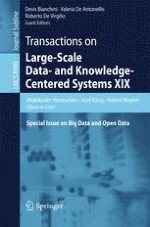The LNCS journal Transactions on Large-Scale Data- and Knowledge-Centered Systems focuses on data management, knowledge discovery, and knowledge processing, which are core and hot topics in computer science. Since the 1990s, the Internet has become the main driving force behind application development in all domains. An increase in the demand for resource sharing across different sites connected through networks has led to an evolution of data- and knowledge-management systems from centralized systems to decentralized systems enabling large-scale distributed applications providing high scalability. Current decentralized systems still focus on data and knowledge as their main resource. Feasibility of these systems relies basically on P2P (peer-to-peer) techniques and the support of agent systems with scaling and decentralized control. Synergy between grids, P2P systems, and agent technologies is the key to data- and knowledge-centered systems in large-scale environments. This, the 19th issue of Transactions on Large-Scale Data- and Knowledge-Centered Systems, contains four high-quality papers investigating the areas of linked data and big data from a data management perspective. Two of the four papers focus on the application of clustering techniques in performing inference and search over (linked) data sources. One paper leverages graph analysis techniques to enable application-level integration of institutional data and a final paper describes an approach for protecting users' profile data from disclosure, tampering, and improper use.
